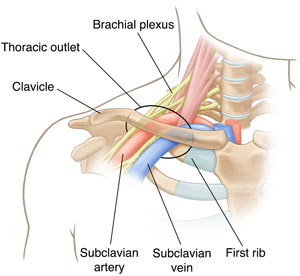Understanding Thoracic Outlet Syndrome
Thoracic outlet syndrome is a set of symptoms in the shoulder, arm, or hand. It occurs from a narrowing of the thoracic outlet. This is the space between your collarbone and your first rib. It can result from injury, disease, or a problem present from birth. Thoracic outlet syndrome is not common. It can occur in people of any age.
What is the thoracic outlet?
The thoracic outlet is a narrow space between your collarbone (clavicle) and your first rib. Nerves and blood vessels pass from your chest to your arm through this area. The nerves and blood vessels include:
-
A bundle of nerves (brachial plexus) that serve your shoulder, arm, and hand
-
A large and important vein (subclavian vein)
-
A very large important artery (subclavian artery)

What causes thoracic outlet syndrome?
Your shoulder muscles normally keep your clavicle raised and in place. But with thoracic outlet syndrome, the upper rib and clavicle are closer. This makes the thoracic outlet smaller. Nerves and blood vessels going through the area can be compressed. Conditions that can cause thoracic outlet syndrome include:
-
Having an extra rib at birth
-
An abnormality in the neck muscles at birth
-
Neck injury
-
Injury to the first rib or collarbone
-
Repetitive overhead arm movements that may cause inflammatory changes
Poor posture and obesity may raise your risk for thoracic outlet syndrome. People who do repetitive overhead arm movements, such as swimmers or pitchers, may also have a higher risk.
Symptoms of thoracic outlet syndrome
Your symptoms may come and go. This may be partly based on your activity level. Overhead activities may make your symptoms worse. You most likely have symptoms on only 1 side. In some cases, thoracic outlet syndrome can cause symptoms on both sides of the body.
Symptoms can include:
-
Aching in your neck, shoulder, arm, or hand
-
Pain, numbness, or tingling of your forearm or fingers, most often the pinky.
-
Hand weakness
-
Limited range of motion of your arm
-
A depression in your shoulder
-
Pain in your neck muscles
-
Swelling and redness of your arm
-
Pale and cool arm and hand
Diagnosing thoracic outlet syndrome
Thoracic outlet syndrome is often more difficult to diagnose than other shoulder problems. Your healthcare provider will ask about your health history and your symptoms. You will also have a physical exam. Your healthcare provider may move your hand and arm in different positions.
A specific test may be done to help diagnose thoracic outlet syndrome. Your healthcare provider may have you raise your arms and then open and close your fist for a few minutes. This often brings on symptoms.
You may have other tests, such as:
-
Nerve conduction tests. This is done to see how your nerves are affected.
-
Needle electromyography (EMG), This is often done with nerve conduction tests. It evaluates the nerve signals going to the muscles.
-
Doppler ultrasound. This looks at blood flow through your arm and hand.
-
Chest X-ray. This is done to check for abnormal bone, such as an extra rib.
-
CT scan. This may be done if your healthcare provider needs to see more detail.
-
CT angiography. This is done to get more information about blood flow through your arm.
Treatment for thoracic outlet syndrome
Depending on the cause of thoracic outlet, different treatments may be needed:
-
Physical therapy to improve range of motion and strength
-
NSAIDs (nonsteroidal anti-inflammatory drugs), such as ibuprofen or naproxen
-
Lifestyle changes, such as weight loss
-
Surgery to relieve pressure on the nerve
-
Surgery to open up blood vessels